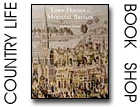Book Review: Town Houses of Medieval Britain
Clive Aslet applauds a fascinating study of the medieval town house from its humble beginnings as an 'urban farm' to the inception of the terrace.


There were no leylandii in the Middle Ages. In other respects, house ownership then offered as many opportunities for neighbours to fall out as it does now. Twelfth-century Londoners protested about water leaks, encroaching sewage, creeping boundaries and smoking chimneys. Drains were a frequent source of complaint in the 14th century, as were windows that allowed neighbours to see more than they ought.
Medieval England was overwhelmingly rural, but more and more people were living in towns. We know about their disputes thanks to the records of special courts set up to deal with them, called Assizes of Nuisance. Until now we have known rather less about the houses they lived in. This book by Prof Quiney fills the gap in our knowledge.
Town houses were not always so different from the rural dwellings from which they derived. To judge from Lydford in Devon and Smarden in Kent - boroughs that never grew to be much bigger than villages - land was not, to begin with, at such a premium that it had to be intensively developed. Townies needed gardens in which to grow vegetables and keep pigs just as much as their country cousins. Houses were set back from the street. This changed in the 14th century, when poor householders supplemented their meagre incomes by renting out miserable rooms that had been run up in any spare angle. But then these rookeries were emptied by the Black Death.
Eventually, commercial pressures led to the development of what is still, in the United States, called the 'row house '. (After the Adam brothers built the Adelphi in the 18th century, the term 'terrace' came into parlance, from the terraces above the Thames on which the development sat.) Hence the Rows in Chester, a type known elsewhere - since such uniform runs of houses tended to be speculative - as 'rents '. This would come to seem a very English form of domestic architecture, but an ever greater national idiosyncrasy was to be found behind the facade.
All but the humblest of house builders clung to the open hall, however wasteful of space and awkward to plan. More rational countries, such as Scotland and France, built upwards; in England, class associations were all. Even in very grand houses, halls took on an increasingly symbolic role-so much so that bishops needed to have two of them, one for ceremony and one to eat with their households.
At every social level, household and family were almost synonymous - although in England (unlike France) only the greatest of families actually referred to themselves as houses. The size of households exploded between 1250 and 1450: a knight who supported a household would now have one of 60.
This book is as strong on such social detail as it is on architectural form. Sometimes the evidence overlaps. InThe Miller's Tale, Chaucer describes how, in the dark, the carpenter 's wife opens a casement in order to present her rear end for the luckless Absolon to kiss. From this, concludes the professor, it ought to be possible to calculate how high the sill was from the ground. It is a fascinating book.
Exquisite houses, the beauty of Nature, and how to get the most from your life, straight to your inbox.
Country Life is unlike any other magazine: the only glossy weekly on the newsstand and the only magazine that has been guest-edited by HRH The King not once, but twice. It is a celebration of modern rural life and all its diverse joys and pleasures — that was first published in Queen Victoria's Diamond Jubilee year. Our eclectic mixture of witty and informative content — from the most up-to-date property news and commentary and a coveted glimpse inside some of the UK's best houses and gardens, to gardening, the arts and interior design, written by experts in their field — still cannot be found in print or online, anywhere else.
-
 Embrace off-grid living on this Scottish island for sale, but you'll have to share it with the local seal population
Embrace off-grid living on this Scottish island for sale, but you'll have to share it with the local seal populationA dot on the map of the west coast of Scotland has come up for sale.
-
 Are you a 'frag head'? Country Life Quiz of the Day, June 30, 2025
Are you a 'frag head'? Country Life Quiz of the Day, June 30, 2025Well, ARE you? And how well do you know Leonardo DiCaprio's 2002 work? It's time to find out.
